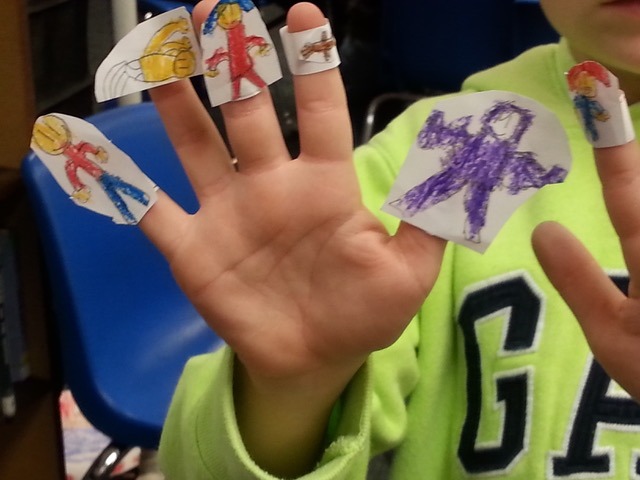Storytelling and STEM – Fran Stallings
Fran Stallings, a storyteller based in Oklahoma, works on a weekly basis with a local 2nd grade class (7- to 8-year-old children). Their classteacher, Mr C, uses the story she tells as the basis for an amazing amount of his teaching, in particular in the STEM subjects.
Fran has posted some details of this work on the Storytell listserv. She has generously given permission for me to publish some of them here – until such time as she creates pages on her own website.
Below are some of them.

Baba Yaga and the Girl with the Kind Heart
For our eleventh session, I told “Baba Yaga and the Girl with the Kind Heart” – a rather longer story than we’ve done so far, but one that divides very neatly into bite-size scenes that are ideal for group retelling or illustrating.
Synopsis: Baba Yaga’s geese steal girl’s baby brother. Hurrying to rescue him before parents return, she helps animals who give her tokens. She finds BY’s house in the forest and snatches the baby but BY wakes and pursues them. Fish’s shell becomes huge lake (BY drinks); squirrel’s nut becomes thorny fence (BY chews a hole); mouse’s pebble becomes mountains. BY goes home, perhaps eats a goose. Parents find girl and baby quietly at home.
[Lurie, Allison: pp 17-22 in Clever Gretchen and Other Forgotten Folktales (Crowell 1980), also in her 1999 paperback The Black Geese (DK Ink).
Motif index Q 2.1.2 CeAb “stolen brother”. See Q 2.1.2 for many other Baba Yaga stories.]
I started by telling the students that Baba Yaga is a fictional character that Russian parents probably used to scare their kids away from genuinely dangerous forests: bears, wolves etc. But to give free rein to the students’ creativity, I carefully avoided using pronouns or description of Baba Yaga so that they could picture their own scariest “bogey in the woods.” (After they have finished drawing, Mr C will show them the conventional Russian picture of BY.) I look forward to seeing their drawings next week!
As usual, after the telling we reviewed the sequence B M E and discussed why the girl is characterized as having a kind heart. What would’ve happened if she had breezed by those animals in her hurry to rescue the baby? I urged them to draw their own images of Baba Yaga, but admitted that a delegation of Russian educators once encountered my students’ artwork in a Stillwater OK school. “Ziz iz not Baba Yaga!” they stormed. We told them that those were American Baba Yagas.
By today, Mr C has already done group retelling exercises with the students. They have started on their pictures and will make finger puppets to place in dioramas illustrating scenes from the story. They have composed a “call back” (he uses these call/response phrases to collect their attention) based on the traditional Russian chant that makes BY’s house settle down on its chicken legs so that you can enter:
(Teacher) “Turn your back to the forest”
(Students) “and your front to me!”
A second call back is:
(Teacher) “The good you do”
(Students) “comes back to you!”
And for this season of [Thanksgiving], he will assign students to write about what each story character might be thankful for. I suggest, from my residency work with this story: Compose a sequel for the further adventures of the girl and her brother. Compare/contrast with other “bogey in the woods” stories. Read other Baba Yaga stories.

STEM suggestions from Mr C:
Design a [non-lethal] trap that can hold Baba Yaga.
Study fish, shells, squirrels, stones, bones, snow.
Study temperature and freezing point of water in F and C (ice cold lake; snow on the mountains).
And all this is in addition to the vocabulary/spelling list he brainstormed with the students! They are learning about spelling changes when singular goes to plural (vis baby/babies).
Who knew there was so much to do with one story.

Below are some more of Fran’s posts
They are in no particular order, but serve to show what is possible.
Visit Fran’s website
to find more about her wide range of work.
In particular, explore the Earth Teller Tales, where she shares many articles about teaching natural science through storytelling.
Fran’s article The Web of Silence: Storytelling’s Power to Hypnotize is a deep exploration of many aspects of the storytelling experience, including the storytelling trance. It also offers great insight into the whole art itself.
Fran can be contacted here.
Further resources relating to storytelling in schools
- Science teaching: Hawthorn Press
- Generally using storytelling in schools: Storytelling schools
Go here for a list of all tales included on this site
Go here to receive an e-mail notification when new tales are added
Permission to tell outlines my views on copyright
For those who are teachers: Telling stories in the classroom: basing language teaching on storytelling
